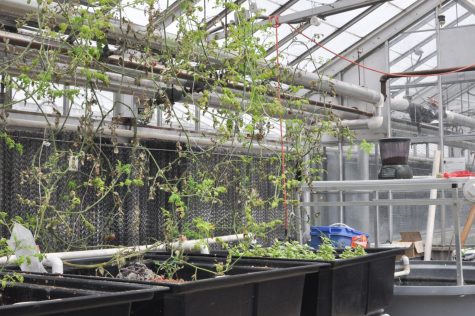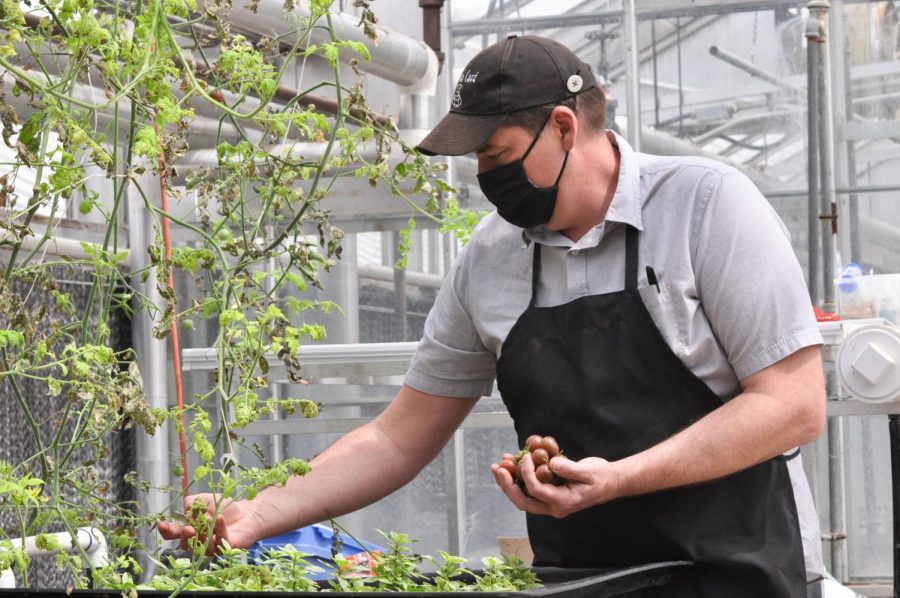Aquaponics takes root in C-U community
Carter Phillips, instructional chef at Bevier Café, plucks tomatoes out of the aquaponics system in the remove space greenhouse on Friday. The system is maintained through Bevier Café for check ups and produce for the café.
April 20, 2022
From harvesting to cooking, produce is transferred from one place to another, leaving consumers on campus unsure about where their food is coming from. Environmental advocates such as Justin Vozzo, graduate student studying natural resources and environmental science, are invested in a systematic approach to improve efficiency on campus — aquaponics.
“What got me into aquaponics ultimately was emulating the natural systems in our agricultural systems and again, like, closing those loops to make things more efficient,” Vozzo said.
Aquaponics is a production system that combines raising fish to maintain plants in water, a mix between aquaculture and hydroponics. The system does not require soil and instead allows plants and fish to complement each other to create a symbiotic relationship.
When fish excrete ammonia, the ammonia is broken down through nitrifying bacteria and turned into usable nitrogen, which is normally found in soil. As fish feed the plants, the plants provide clean water in return. Therefore, this system can reduce water usage, fossil fuels and transport costs.

“It’s not just about cutting carbon,” Vozzo said. “It’s about how can we use those resources that we have available to use on this planet most efficiently so that we can … sustain them for as long as possible.”
Get The Daily Illini in your inbox!
Despite the challenges in organizational and funding logistics, dedicated organizations and staff members supported the fruition of his project. After his freshman year, Vozzo submitted his idea of implementing an aquaponics system to the Student Sustainability Committee in 2015 for funding.
“This is definitely only possible because we have a funding body on campus like the Student Sustainability Committee,” Vozzo said. “Otherwise, it just wouldn’t have (ever) happened.”
Following the success, Vozzo found Carter Phillips, instructional chef in the Food Science and Human Nutrition Department, who was able to provide a permanent home for the project after Vozzo’s undergraduate graduation. Throughout the implementation, they harvested generations of fish such as tilapia and grew leafy greens.
“Aquaponics has been something that I’ve been interested in for many years,” Phillips said. “I had a small aquaponics system set up at my house. Just the symbiosis between the fish and the plants — it really kind of spoke to me.”
The system continues to run for Bevier Café on campus. Phillips and his team members at the café maintain the aquaponics through weekly checks on the fish and water quality. The benefit of having aquaponics in the staff’s proximity is how it serves as an educational tool. Phillips sees students come from urban areas that do not have the opportunity to grow their own produce forming a connection with food.
“To put a seed into the ground or, in this case, an aquaponics system and watch it grow, there’s a connection with that food that gives you a little more respect not only for where it came from, but, you know, there’s some mental peace of mind as well in that process,” Phillips said.
Bevier Café is not the only location that houses an aquaponics system in the greater C-U community. On March 24, Holy Cross School in Champaign revealed its own aquaponics system that was provided by Sky-High Aquaponics, a division of Tryon Technologies Inc.

Holy Cross School’s aquaponics system is very similar to the University’s system, composed of many of the same integral parts. The school’s system includes a closed-loop process where tilapia and plants provide nutrients to each other, eventually resulting in the growth of food within the system.
Greg Koerner, principal of Holy Cross School, previously expressed his desire to have a curriculum that would allow the school to stand out among other schools. When a community member on Koerner’s marketing team suggested aquaponics, Koerner and the rest of the team explored what aquaponics involved and connected with the CEO of Tryon Technologies Inc.
After research was conducted, designing the curriculum was a key next step.
Meghan Burgess, a fifth-grade teacher at Holy Cross School, valued the opportunity to be one of the teachers that would construct the curriculum. Burgess used the skills she learned from her master’s degree in Curriculum & Instruction at the University to create a curriculum that would provide students the opportunity to learn about aquaponics in all their classes.
“One thing we’re working on right now is being able to develop a curriculum that doesn’t just teach this in the science class,” Burgess said. “If a kid can see that something you learn in science also relates to what you’re learning in social studies and in writing and in art, that makes the experience that much more meaningful for them.”
Burgess provided specific examples of teaching aquaponics in subjects other than science. She described the potential for students to explore aquaponics’ past and future in history class, measure and collect data in math class and draw the plants and the stages of their growth in art class.
The benefits of the school’s aquaponics system extend beyond the students’ education and the provision of food for the school’s lunch program. Koerner envisioned potential partnerships with clubs and organizations such as the Daily Bread Soup Kitchen, Harvest Market and the Champaign-Urbana Rotary Club in the local community so that community needs are met.
Burgess explained that the impacts on the students and community are connected since the curriculum can lead to students’ greater understanding of community needs. Burgess said that students are the future and that their understanding of the resources in the community influences them to think on a larger scale with resource issues.
“If (the students) are able to actually be part of the process of planting the seed, growing the food, giving it to somebody and seeing how it can actually be used in an actual dish for those who, you know, maybe are less fortunate or cannot get the meal that they need, I think that’s going to be huge for the students,” Burgess said.
Even with the challenges that accompany the development of the aquaponics system, Burgess highlighted how these opportunities for problem solving can be part of the students’ education as well.
“It’s gonna be a lot of learning as we go, and I think that that’s really important for kids to see as well, that we are kind of all learning this together,” Burgess said. “They get to learn like, ‘Okay, what do we do to fix this?’”
When considering the future of the aquaponics system in the school, Burgess wondered how much space is available for more towers to be introduced while Koerner discussed the possibility of expanding the system to other schools.
“In the 2023-2024 school year, we have the curriculum, and if any other Catholic school in the diocese wants one of these towers, they can get a tower,” Koerner said. “I see that expansion through the diocese. I also then see the expansion to public schools if they want that opportunity to serve and create agricultural programs.”
Koerner said he wonders what it would look like if the towers were suitable for the public, exploring the potential for the development of aquaponics to increase beyond its existence within the University and Holy Cross School.
“I’ve also talked to Tryon about downsizing these towers to make it more sustainable for somebody at home to have one of these in their basement or backyard,” Koerner said. “We also want to help Tryon with the promotion of these towers to every household that wants one.”







